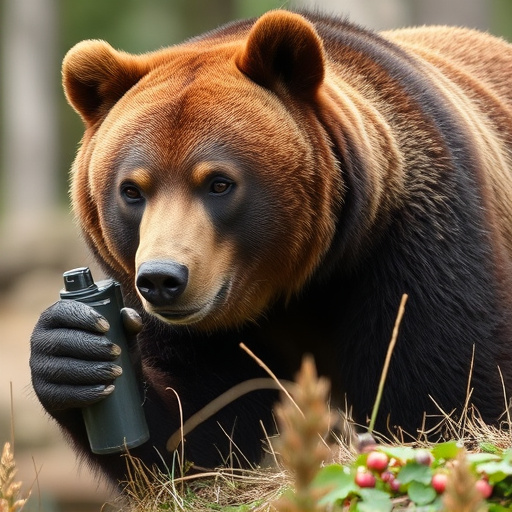Bear spray is a useful but potent tool in bear country. Improper usage and disposal can contaminate soil with capsicum derivatives, harming plants and water quality for months. Understanding soil contamination risks, especially in remote areas, is crucial. Responsible disposal methods, duration-based application, and gear cleaning are essential to protect both humans and wildlife.
Alaska’s rugged landscapes attract adventurers, but coexisting with bears requires responsible bear spray usage. This article delves into the critical aspects of bear spray safety, focusing on soil contamination and duration of residual effects. We explore how bear spray impacts Alaska’s unique ecosystems and offer best practices for its remote use and disposal. Understanding these factors is essential to mitigating environmental risks and ensuring safe interactions with bears.
- Understanding Bear Spray Safety and Its Impact on the Environment
- Soil Contamination: How Bear Spray Can Affect Alaska's Ecosystems
- Duration of Bear Spray Residue: Long-Term Effects and Safety Measures
- Best Practices for Responsible Use and Disposal in Remote Areas
Understanding Bear Spray Safety and Its Impact on the Environment
Bear spray is a popular tool for personal safety in areas inhabited by bears, but improper usage and disposal can have significant environmental impacts. When used correctly, bear spray can effectively deter aggressive bears and provide valuable time to escape potentially dangerous situations. However, if not managed responsibly, it can lead to soil contamination, especially in sensitive ecosystems. The active ingredients in bear spray, primarily capsicum derivatives, can persist in the environment for varying durations, affecting water quality and plant life.
Understanding the potential for bear spray to contaminate soil is crucial. This is particularly important in remote areas where bears roam freely and human activity may be less regulated. Proper disposal methods, such as containment and specialized waste facilities, are essential to minimize environmental damage. The duration of impact should also guide users’ decisions on when and where to deploy bear spray, ensuring its use aligns with ecological considerations alongside personal safety.
Soil Contamination: How Bear Spray Can Affect Alaska's Ecosystems
Bear spray is a popular tool for personal safety in areas inhabited by bears, but its improper use and disposal can lead to significant soil contamination. When bear spray comes into contact with the ground, it can persist for extended periods, potentially harming Alaska’s delicate ecosystems. The active ingredients in bear spray, primarily capsicum derivatives, are highly toxic to plants and wildlife when present in high concentrations.
Soil contamination from bear spray can impact the growth and survival of native flora and fauna. It may disrupt nutrient cycles, inhibit seed germination, and even lead to long-term ecological changes. Moreover, contaminated soils can affect non-target species, including birds, insects, and other mammals, which rely on these habitats for food and shelter. The duration of this impact can vary based on factors such as spray concentration, soil type, and weather conditions, but it is crucial to use and dispose of bear spray responsibly to minimize its environmental footprint in Alaska’s pristine landscapes.
Duration of Bear Spray Residue: Long-Term Effects and Safety Measures
The duration of bear spray residue and its potential long-term effects on the environment and human health is a significant concern, especially in areas where bears are prevalent. Bear spray soil contamination can persist for extended periods, depending on various factors such as climate conditions, vegetation type, and soil composition. Research indicates that residual chemicals from bear spray can remain active for weeks to months, leaving a trace that may impact wildlife and plant life.
Safety measures are crucial when using bear spray to mitigate these risks. Users should be aware that even after the initial misting, tiny droplets of the spray can still be present in the environment. To ensure safety, it’s essential to thoroughly clean any gear or clothing that has come into contact with bear spray and avoid direct contact with soil for a period recommended by manufacturers. This proactive approach helps minimize soil contamination and protects both humans and wildlife from potential long-term exposure to residual chemicals.
Best Practices for Responsible Use and Disposal in Remote Areas
When using bear spray in remote areas, adhering to best practices is paramount to minimize environmental impact and ensure safety. It’s crucial to avoid soil contamination by always disposing of cans responsibly – never leave them behind or throw them into bodies of water. Instead, bury them deep in a marked location far from trails or campsites, ideally after the spray has fully decomposed, which typically takes around 2-3 years.
Proper usage duration is another key factor. Follow manufacturer instructions for recommended application times and distances. Using more than necessary can lead to wastage and potential ecological disruption. Regularly check expiration dates to ensure the spray remains effective, as its potency can diminish over time, especially in harsh weather conditions.
Bear spray is a valuable tool for personal safety in bear country, but its misuse and improper disposal can lead to significant soil contamination. Understanding the duration of bear spray residue and its environmental impact, especially in Alaska’s delicate ecosystems, is crucial. By adopting best practices for responsible use and proper disposal, we can ensure the safety of both people and wildlife while minimizing the long-term effects of bear spray on our environment. Let’s be mindful of how our actions in remote areas can affect this unique landscape, preserving it for future generations.
